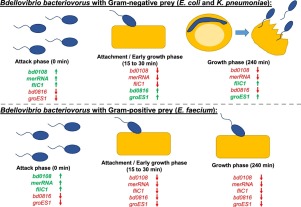Microbiological Research ( IF 6.7 ) Pub Date : 2020-02-13 , DOI: 10.1016/j.micres.2020.126437 Monique Waso 1 , Sehaam Khan 2 , Warish Ahmed 3 , Wesaal Khan 1

|
The expression of attack phase (AP) and growth phase (GP) genes of Bdellovibrio bacteriovorus (B. bacteriovorus) was compared in the presence of Gram-negative [Escherichia coli (E. coli) and Klebsiella pneumoniae (K. pneumoniae)] and Gram-positive [Enterococcus faecium (E. faecium)] prey, using relative quantitative polymerase chain reaction (relative qPCR) assays. The genes bd0108 (pili retraction/extrusion) and merRNA (massively expressed riboswitch RNA) were highly expressed in the AP cells [3.99- to 6.06-fold (E. coli), 3.91- to 7.05-fold (K. pneumoniae) and 2.91- to 7.30-fold (E. faecium)]. The fliC1 gene (flagella filament) was also expressed at a high level in the AP cells however, after 240 min of co-culture with E. faecium the expression of fliC1 remained low (at 0.759-fold), while in the presence of the Gram-negative prey fliC1 expression increased. Additionally, the GP genes bd0816 (peptidoglycan-modifying enzyme) and groES1 (chaperone protein) were not induced in the presence of E. faecium. However, they were expressed in the early GP and GP of B. bacteriovorus after exposure to the Gram-negative prey. It can thus be concluded that B. bacteriovorus senses the presence of potential prey when exposed to Gram-positive and Gram-negative bacteria, however the GP genes are not induced in co-culture with E. faecium. The results from this study thus indicate that B. bacteriovorus does not actively grow in the presence of E. faecium and the second predatory cue (induces active growth of B. bacteriovorus) is lacking when B. bacteriovorus is co-cultured with the Gram-positive prey.
中文翻译:

在革兰氏阴性和革兰氏阳性猎物的存在下,Bdellovibrio bacteriovorus攻击和生长期基因的表达。
比较了革兰阴性[大肠杆菌(E. coli)和肺炎克雷伯氏菌(K. pneumoniae)]的存在下细菌Bdellovibrio(B.细菌)的攻击期(AP)和生长期(GP)基因的表达。革兰氏阳性[粪肠球菌(E. faecium)]猎物,使用相对定量聚合酶链反应(相对qPCR)分析。基因bd0108(菌毛回缩/挤出)和merRNA(大量表达的核糖开关RNA)在AP细胞中高度表达(大肠杆菌为3.99至6.06倍,大肠杆菌为3.91至7.05倍(大肠杆菌)。肺炎克雷伯菌)和2.91至7.30倍(屎肠球菌)]。所述FLIC1基因(鞭毛长丝)也在AP细胞然而以高水平表达,与后240分钟共培养的屎肠球菌的表达FLIC1仍然很低(在0.759倍),而在的存在革兰氏阴性猎物fliC1表达增加。另外,在屎肠球菌的存在下,GP基因bd0816(肽聚糖修饰酶)和groES1(伴侣蛋白)没有被诱导。但是,它们在早期的GP和GP中表达。暴露于革兰氏阴性猎物后。因此可以得出结论,当暴露于革兰氏阳性和革兰氏阴性细菌时,细菌噬菌芽孢杆菌会感觉到潜在的猎物的存在,但是在与屎肠球菌共培养中并未诱导GP基因。因此,这项研究的结果表明,在粪肠球菌的存在下,细菌杆菌不活跃生长,并且当细菌杆菌与革兰氏菌共培养时,缺乏第二种掠食性线索(诱导细菌噬菌体的活跃生长)。积极的猎物。


























 京公网安备 11010802027423号
京公网安备 11010802027423号